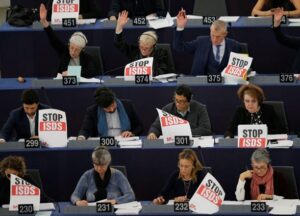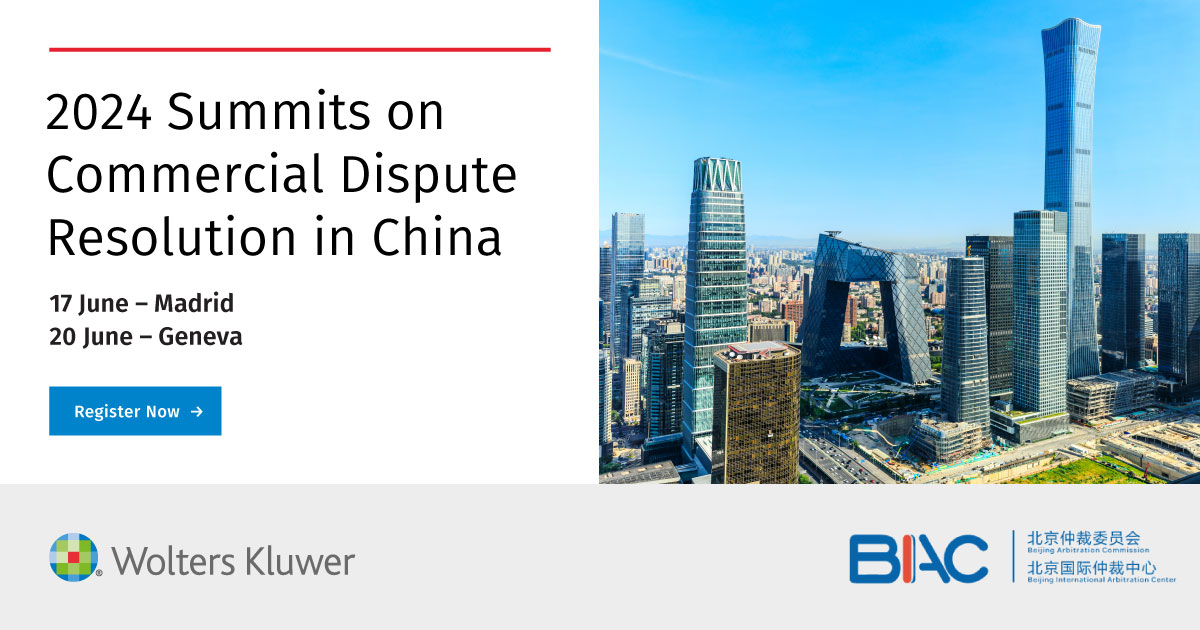“Corporations have their own global private court system – called ISDS – which they use to bully governments. But many victims of corporate human rights abuses don’t have any way of winning justice. This is unfair. We need to end these corporate courts now! Rights for people, rules for corporations.” Letter from the Stop ISDS movement to the President of the European Union Council (2019)
Arbitration lawyers are proud of their profession. Foundational works like ‘dealing in virtue’ and ‘arbitrating for peace’ show just how much they see themselves as a force for good, easing global tensions and fostering peace, even averting war through a system grounded in honour.

But this has changed. Thousands have gathered across Europe to protest against investment treaties like CAFTA, TTIP, CETA, and NAFTA, repelling their arbitration clauses. Protesters feel exploited by arbitration or, as they call it, “corporate courts.” (© Jess Hurd reproduced from Global Justice Now)

In 2023, several EU members left the ECT, the largest investment arbitration treaty, after accusations that companies “weaponise” this “climate-wrecking,” “climate-killing” “obscure energy treaty” to promote “ecocide” through “biased secret courts.” Like Dorian Gray’s fate, the once clean portrait of arbitration now reflects not virtue or peace, but a more contentious legacy.
(Members of the European Parliament protest against ISDS Ⓒ REUTERS/Alamy Stock Photos, reproduced from Chatham House)
However, we propose an alternative. Emerging over the last 20 years and distant from European controversies, unlike ‘multilateral investment courts’ or ‘ombudsman’ proposals, BRAMIA is a time-tested and conservative alternative to ISDS, that shifts perceptions of power back to the people while still protecting investors. To explain how it works, we’ll take two steps back.
BRAMIA: The Outlier in Numbers
BRAMIA initially evolved in Brazil. There are reasons why. Statistically, Brazil is the second largest source of ICC arbitrations in the world. Out of which, one fifth involve state entities. The ICC offices in São Paulo report that almost 85% of their total amount in dispute regards cases with Brazilian state entities [fn] As informed by the ICC’s Counsel during the 2022 Brazilian Arbitration Day organized by the ICC in São Paulo, Brazil. [fn] . In 2022, the country with the largest docket registered at ICSID and the PCA combined was Peru, with 8 cases. In that same year, disputes with Brazilian state entities accounted for at least 36 new arbitrations.
According to the World Bank, in 2022 Brazil attracted approximately USD 91 billion in FDI, a considerable amount compared to India (USD 49 billion), Mexico (USD 39 billion), Chile (USD 20 billion), Argentina (USD 15 billion), and South Africa (USD 9 billion). These countries signed most of their IIAs in the 1990s, a time when they had an FDI inflow equivalent to that of Brazil.
Other nations might struggle with legitimacy issues, but in Brazil, oil and gas, infrastructure, natural resources, concessions, and other matters related to state interests are arbitrated with no protests while investment still peaks. How?
The Grey Zone: Commercial or Investment Arbitration?
Academics love to categorise. In doing so, they’ve concluded that Brazil never had ISDS. The country historically refused to ratify any treaties containing recourse to arbitration and, as so, arbitration with state entities was always contract-based and, thus, categorised as commercial.
But reality is not that simple. Investment arbitrations can be based on treaties, but also contracts, or even national laws. Their applicable laws and substantive standards can oscillate between public international law, the law of the contract or the national law of the host State. They can even be administered by the ICC, or the PCA, under a domestic lex arbitri and enforced through the NY Convention. There is not one single legal characteristic that sets commercial and investment arbitration apart. Like childhood and adulthood, these types of arbitration are just clusters of characteristics on a continuum, not strictly separate categories. And, as day and night, they are mediated by a grey zone, in which disputes can incorporate varying degrees of traditionally commercial or investment features. In other words, if it looks, works, and behaves like investment arbitration, it probably is.
We argue that Brazil, rather than lacking investment arbitration, operates one of the most successful – yet quiet – investment arbitration models in the world, leveraging this grey zone through BRAMIA, the Brazilian Model of Investment Arbitration.
Why and How It Works
Contractualising Regulation
In Brazil, large projects in sectors like infrastructure, transport, and energy, often are conducted or overseen by state entities. This process is governed by contracts that incorporate directly or indirectly most aspects of the host State’s regulatory framework, distinguishing it from other countries where these would be extracontractual matters. Then, rather than utilizing BITs to grant arbitration access to their principal investors, the host State can simply embed arbitration clauses within these contracts. For instance, environmental regulation issues, often discussed through treaty ISDS, give rise instead to contractual claims in the expanded the scope of contract-based arbitration. Likewise, regulatory matters that might normally be settled by treaty arbitration in other nations are addressed through contractual arbitration, which is the starting point for this contractual model of investment arbitration.
Power Shift
In conventional ISDS, treaties roll out the red carpet for any investor to challenge states in international arbitration. This indiscriminate welcome results in a conundrum where parties who might be deemed insignificant can drag states into global legal skirmishes. ISDS’s best answer to this has been the Salini Test, which relies on a creative – and rather controversial – interpretation of the preamble of the ICSID convention to bar unwanted claimants.
BRAMIA, by contrast, allows state entities to hold the proverbial pen, granting them the prerogative to decide if, when and with whom arbitration may be agreed upon. It works like this: the state scripts arbitration directly into a concession contract, should it choose to do so. Otherwise, there is no arbitration. Arbitration is treated as a highly strategic tool, used to attract investment when there is a significant potential for investment and a mutually beneficial interest between the State and the potential investor. No need for creatively interpretating treaty preambles. And it’s not only the choice to go or not to arbitration. Under BRAMIA, the state tailors each arbitration to fit the dispute’s unique context beforehand, considering the economic sector, investment, and relevant interests, instead of conventional ISDS’s one-size-fits-all approach.
Dispute Design and Public Participation
In treaty ISDS, arbitration often follows the generic framework of an IIA, which restricts a state’s influence over the specific dispute, potentially impacting legitimacy as it may appear to surrender sovereignty to external entities. Contrastingly, BRAMIA allows some state and social control over dispute proceedings. Arbitration clauses are suited to individual investments, included by the host State in tenders or contracts, and can be readjusted or negotiated later. These contracts undergo public hearings where investors, scholars, lawyers, and activists can share their opinions. Regulatory agencies like ANP, ANAC, and ANTAQ (responsible for Oil & Gas, Aviation and Ports regulatory supervision) have even reshaped arbitration clauses after public hearings, strengthening public perceptions of legitimacy. In fact, the ANP inserted PCA clauses in its oil contracts only after public consultation, pre-empting legitimacy problems. Transparency is the general rule in all arbitrations with state parties. State entities develop teams of highly skilled government attorneys to represent them in arbitral proceedings.
Annulments
In ICSID arbitration, annulment is handled by a committee appointed by ICSID itself, comprised of foreigners and based on public international law, bypassing host State courts. While intended to protect the award, it can suggest local courts are unfit to identify flaws or annul the decision, raising legitimacy problems. Under BRAMIA though, for most contracts, state courts can still annul awards but do so cautiously, only under clear statutory grounds applicable to any set-aside action. It’s a fine balance. The state never overplays its political hand, and the judiciary remains arbitration-friendly. This bolsters investors’ confidence without undermining the feeling of national sovereignty.
Cultural Gaps
In classical ISDS, arbitrators often come from different nations than the disputing parties, aiming for neutrality but risking cultural and legal misunderstandings, thus affecting legitimacy. Contrastingly, under BRAMIA, arbitrators are typically from the host State, based there or with strong ties to it, even the ones appointed by investors. This practise provides local cultural insight and avoids the perception that foreign-dominated courts favour foreign companies in issues that affect national collective interests.
Applicable Law
In ISDS, public international law often overrides local laws, leading to discomfort for host States when arbitrators, using international law, find state actions to violate treaty terms albeit being lawful domestically. However, under BRAMIA, domestic laws govern arbitrations unless stated otherwise, aligning arbitrator decisions with state regulatory concerns, and reducing the chance of discomfort.
Conclusion
Much like what happened when Bumble appeared, BRAMIA tilts the power balance back towards the party which often finds itself more exposed, putting them in a more comfortable setting. BRAMIA’s primary feature is the sense of empowerment it provides to the State, which in turn bears the responsibility for the success of its investment policies. While sensitive issues become controversial in ISDS, government counsel working under BRAMIA welcomes them: “Arbitration is no longer seen as an alternative means of dispute resolution, but rather as the most suitable method for handling certain types of conflicts, such as sensitive and complex sectoral infrastructure issues.”
Yet, BRAMIA is not a universal solution. It flourishes under specific conditions: an autonomous judiciary, refined governance structures, transparency and professionalism, and a fine balance between regulatory interests and respect for investments. We know that some of our statements might ruffle feathers— for example, that BRAMIA represents a third genre of arbitration, which lies in the twilight between classical commercial and investment arbitration. This is why we’ve detailed our positions in a comprehensive article in Portuguese, with an English extended version on the horizon.
But if you’re still not convinced, let us step back from the legal technicalities. Consider instead the research of Jaak Pankseepp on the play patterns of rats. When two rats engage in rough-and-tumble play, the larger rat must allow the smaller companion a taste of power — a minimum of 30% success rate — if they are to keep playing in the long run. Otherwise, if the smaller one perceives the other to be a bully, “playful activity gradually diminishes and the less successful animal begins to ignore the winner.” If it feels bullied, it stops playing. This pattern is seen in most mammals.
Investment and commercial arbitration are games with their own sets of rules and rituals, where the contenders compete to win. Now, revisit the epigraph to this post. It’s clear that some people feel tyrannised, and such games do not last. Our real challenge is to craft an arbitration model that encourages play over time, unlike what may have unfortunately happened to classical ISDS. And if one such model already exists, why not try it?
BRAMIA shows that, be it rat play, dating apps, or arbitration, flipping the script makes all the difference in who feels in power — and who’s willing to keep playing.
________________________
To make sure you do not miss out on regular updates from the Kluwer Arbitration Blog, please subscribe here. To submit a proposal for a blog post, please consult our Editorial Guidelines.


